GENERAL HUNTING INFORMATION
HUNTING LICENSES
All resident hunters age 16 through 74 must have a resident hunting license unless exempt. Nonresident hunters, regardless of age, must have a nonresident license. Annual hunting licenses expire one year from the date of purchase. Resident hunters age 65-74 qualify for Senior Pass lifetime hunt/fish combination licenses ($42.50), senior annual hunting licenses ($15), or annual hunt/fish combination licenses ($25). Residents age 16-20 qualify for Youth Multi-year hunting ($42.50) or hunt/fish combination licenses ($72.50), which expire the end of the year they turn 21.
A resident is defined as a person who has maintained that person’s place of permanent abode in the state for 60 days prior to purchase. Domiciliary intent is required, evidence of which may include where a person votes, pays personal income taxes, or obtains a driver’s license. Residency of at least one year is required to purchase lifetime licenses.
Lifetime license holders are considered Kansas residents for hunting permits and tags, even if they no longer live in Kansas.
Hunters may purchase a special license that is valid only on controlled shooting areas.
Nonresidents who are full-time secondary, post-secondary or vocational students at Kansas schools and are living in Kansas may obtain resident hunting licenses and permits but must carry evidence of Kansas student status. They may NOT purchase lifetime licenses.
LICENSE EXEMPTIONS
The following persons are not required to have a hunting license:
- owners of farm or ranch land or tenants of land leased for agriculture, and immediate family members living with resident landowners and resident or nonresident tenants, while hunting or furharvesting on this land;
- legally-defined Native American Kansas residents (may obtain free license, restrictions apply);
- nonresidents using field trial permits issued by KDWP; and
- residents 15 and younger or 75 and older.
NATIONAL GUARD, DISABLED VETERANS
The Kansas Legislature annually allocates funding to provide state park vehicle permits and hunting and fishing licenses to active members of the Kansas National Guard. Funding is also allocated to provide hunting and fishing licenses to honorably discharged resident veterans certified with a service-related disability of 30 percent or more.
MILITARY
Military personnel ARE required to have hunting or furharvesting licenses. Nonresident military personnel not stationed in Kansas must have nonresident licenses. Active-duty members who were Kansas residents immediately prior to enlistment – and their immediate family members living with them – may purchase resident licenses, regardless of duty station.
Active-duty nonresident military personnel stationed in Kansas may hunt or furharvest with resident hunting or furharvesting licenses, if they carry evidence identifying them as active-duty military personnel.
HUNTER EDUCATION
Anyone born on or after July 1, 1957, must complete an approved hunter education course before hunting in Kansas. Anyone under 27 years old must carry their hunter education card while hunting. Students must be at least 11 years old to be certified. Youth 12-15 who have completed hunter education may hunt without adult supervision (except during youth seasons when adult supervision is required regardless of hunter education).
Exceptions include youth 15 and younger who may hunt without hunter education while directly supervised by an adult 18 or older. Anyone 16 or older who has not completed hunter education may purchase up to two apprentice hunting licenses. An apprentice license is valid one year from date of purchase, and the holder must be under the direct supervision of a licensed adult 18 or older when hunting. Hunter education is not required while hunting one’s own land.
Kansas resident hunters age 16 and older may receive the required Kansas hunter education certification by completing the NRA Complete Online Course, availablefree of charge. All hunter education delivery options can be viewed at: ksoutdoors.com/Services/Education/Hunter.
Duplicate certificates are provided at no cost at KDWP regional, district and state park offices, online or by calling (620) 672-0773.
TRESPASS
It is illegal to hunt, shoot, or trap on private land without the owner’s permission. Hunting from public roads requires permission of the landowner adjacent to the side of the road being hunted. No hunting is allowed from state or federal highways. Railroad rights-of-way require permission from the railroad.
Written permission is required to enter land posted with hunting and/or trapping by “Written Permission Only” signs, or land having trees or fence posts painted purple. It is illegal and dangerous to mount blinds or treestands on power poles, whether they appear abandoned or not.
GIVING, RECEIVING GAME
Game given to another person must be accompanied by the donor’s name, address, license, transaction or permit number, and signature, as well as the date of donation. Contact KDWP for suggested donation form.
SELLING GAME MEAT
It is illegal to sell wild game meat. This includes the sale of game at banquets or charitable events. Furbearer meat may be sold.
ILLEGAL ACTIVITIES
THE FOLLOWING ACTIVITIES ARE PROHIBITED:
- using drugs, chemicals, or any chemical compound as part of or in conjunction with broadhead arrows to take game;
- shooting at, killing, or pursuing game from a motorboat, airplane, motor vehicle, or other water, air, or land vehicle unless such person holds a valid handicapped hunting permit; exceptions include hunting waterfowl from a boat with motor shut off or sails furled and progress ceased. Coyotes may be pursued with a vehicle;
- using two-way radios or cell phones in any manner for the purpose of pursuing, chasing, or hunting game animals or furbearing animals, or to giveinformation concerning the location of big game by radio or mechanical means;
- using live decoys;
- using electronic calls, except for hunting coyotes, furbearers, rabbits, hares, squirrels, crows, or light geese during the conservation order;
- throwing or casting the rays of a spotlight, headlight, or other artificial light on any highway, roadway, field, grassland, woodland, or forest for the purpose of spotting, locating, or taking any wildlife species while having in possession any archery, firearms, or other implement whereby wildlife could be taken, unless hunting coyotes (see Pages 44-45 for restrictions). Hand-held, battery-powered flashlights, hat lamps, or hand-held lanterns may be used with .17 and .22 rimfire rifles and handguns to take trapped furbearers, trapped coyotes, or furbearers treed by dogs;
- shooting at migratory doves, quail, pheasants, and prairie chickens unless they are in flight; shooting at turkeys unless they are on the ground or in flight; and
- using a drone for hunting, locating wounded or harvested game or taking fish. A drone can be used to scout on land not owned or managed by KDWP. However, hunting is not allowed on the same day the aerial scouting occurs.
NON-TOXIC SHOT
Approved non-toxic shot is required when hunting ducks, geese, mergansers, coots, snipe, rails, gallinules, sandhill cranes and moorhens. Non-toxic shot is required for all shotgun hunting on the following wildlife areas (WA) and national wildlife refuges (NWR):
Benedictine Bottoms WA, Cheyenne Bottoms WA, Cherokee Lowlands WA, Flint Hills NWR, Gurley Salt Marsh WA Herron Playa WA,Isabel Wetlands WA, Jamestown WA, Kirwin NWR, Marais des Cygnes NWR, Marais des Cygnes WA, McPherson Wetlands WA, NeoshoWA, Otter Creek WA, Quivira NWR, Slate Creek WA, Stein Playa WA, Talmo Marsh WA, Texas Lake WA, Wild Turkey Playa WA, and otherareas as posted.
WANTON WASTE
Hunters must attempt to find any game crippled or killed. Retrieved animals must be kept until they are eaten, taken to a taxidermist or processor, given away, ortransported to the hunter’s residence.
SALVAGE OF GAME ANIMALS
Dead game animals and furbearers may be possessed in season with proper licenses and within legal limits. Dead big game animals and wild turkeys may be possessed outside of the season with KDWP salvage tags. Antlers may not be cut off roadkills or found skulls and possessed without this tag.
PRAIRIE DOGS
Kansas residents are not required to have a hunting license to hunt prairie dogs. Nonresidents must have a nonresident hunting license to hunt prairie dogs. They may be hunted statewide and there is no closed season or bag limits. Most prairie dogs are found in the western-most Kansas counties, particularly in the northwest. Nearly all huntable prairie dog towns are located on private land, and access requires landowner permission. The best way to locate prairie dog towns is through satellite images. Once a large town is located, landowner contacts may be found through a rural plat map.
REPTILES/OTHER SPECIES
Kansas residents do not need a hunting license to take moles or gophers. Unless exempt, a hunting license is required to take ground squirrels, woodchucks, kangaroorats, wood rats, armadillos, porcupines, feral pigeons, starlings, house sparrows, rodents, and certain amphibians and reptiles.
Season is open year-round. There is no possession limit except on amphibians and reptiles – five of any one species. The take of bullfrogs, common snapping turtles, andsoftshell turtles requires a fishing license and is covered under fishing regulations.
Anyone may obtain a special permit to commercially harvest prairie rattlesnakes at a special rattlesnake roundup only. Permits for those with a validKansas hunting license or those not required to have a hunting license are $7.50. Permits for those without a valid hunting license are $22.50. Prairie rattlesnakes may be taken only by hand, snake hook, or snake catcher. This applies to commercial harvest of prairie rattlesnakes (Crotalus viridis viridis) only. No other rattlesnake species may be taken commercially. Timber rattlesnakes are protected. Phone (620) 672-5911 for more information.
OFFICER CHECKS
Law enforcement officers may enter fields and lands to check hunting licenses and bag limits. Hunters must be in immediate possession of their licenses and permits or have them stored on a mobile unit in their possession and allow an officer to inspect license and permits, as well as any wildlife in their possession.
COMMON CONCERNS
DEER
- A hunter may purchase only one antlered deer permit.
- No individual shall copy, reproduce, or possess any hard copy or reproduction of a big game or wild turkey permit or carcass tag. Hunters may possesse-licenses, e-permits and e-tags on a mobile device.
- It is legal to bait deer, turkey, and other non-migratory game animals on private lands. It is not legal to bait while hunting or preparing to hunt on department or WIHA lands.
- Harvested big game and turkey must be properly tagged, or e-tag confirmation number obtained, before moving carcass or parts from harvestsite.
- No Either-species Antlerless deer permits, which allow the harvest of mule deer does, are available for the 2022-2023 seasons.
- No Whitetail Antlerless Deer permits are valid in Unit 18.
GAME TRANSPORT
- Pheasants being transported must retain a foot, plumage, or some part that identifies the birds as males.
- Migratory game birds (except mourning/white-winged doves) must have one fully-feathered wing or head attached while in transport.
EAGLES, HAWKS, OWLS AND SONGBIRDS ARE PROTECTED
- It is illegal to kill or pursue eagles, hawks, owls, or songbirds, or possess their parts, except by special permit. Call (620) 672-5911 for details.
HUNTING FROM A VESSEL
- When hunting from a vessel, all boating statutes and regulations apply. See ksoutdoors.com/Boating for a complete list.
DEFINITION OF TAKE
- ‘‘Take’’ means harass, harm, pursue, shoot, wound, kill, molest, trap, capture, collect, catch, possess or otherwise take, or attempt to engage in any such conduct.
PUBLIC LANDS
- Target shooting is allowed only at designated shooting ranges. Off-road vehicle use is allowed only by special permit.
HOGS
- Feral hogs threaten agricultural crops and native wildlife in several Kansas counties. The state’s goal is to eradicate or reduce the feral swine population to the lowest possible level. Sport hunting is not effective at controlling feral hogs and is illegal. Landowners or legal occupants of the land or their employees may shoot feral hogs on their property without a permit. All other persons wishing to shoot feral swine must have a permit issued from the livestock commissioner at the request of the landowner. For more information, call the Kansas Animal Health Division at (785) 296-2326 or USDA Wildlife Services at (785) 537-6855.
REGULATION CHANGES
- Regulation changes may occur after the 2022-2023 Kansas Hunting & Furharvesting Regulations Summary has been printed and distributed. Updates will be posted on ksoutdoors.com and the GoOutdoorsKS mobile app, and emailed when they become available.
DEER REGULATIONS
KANSAS DEER MANAGEMENT
Harvesting female deer is the most effec- tive way to control deer where deer numbers exceed people’s tolerance due to damages or disturbances they may cause. Hunting may also be used to control deer problems and maintain a population that habitat supports.
Deer adapt to hunting pressure and find areas where they can evade hunters. In some cases, those areas are created because a particular landowner desires to restrict or prohibit hunter access. Protected areas serve as refuges and may result in future herd increases and higher deer dam- age on adjacent or other properties where protected deer spend time when hunting season is closed.
Landowners have several options for con- trolling deer on their property: 1) allow or increase hunting; 2) encourage hunters to harvest antlerless deer; 3) contact KDWP at (620) 672-5911 for the hunter referral list; or 4) apply for deer control permits that may be used when damage occurs while normal hunting seasons are closed.
DEER MANAGEMENT UNITS
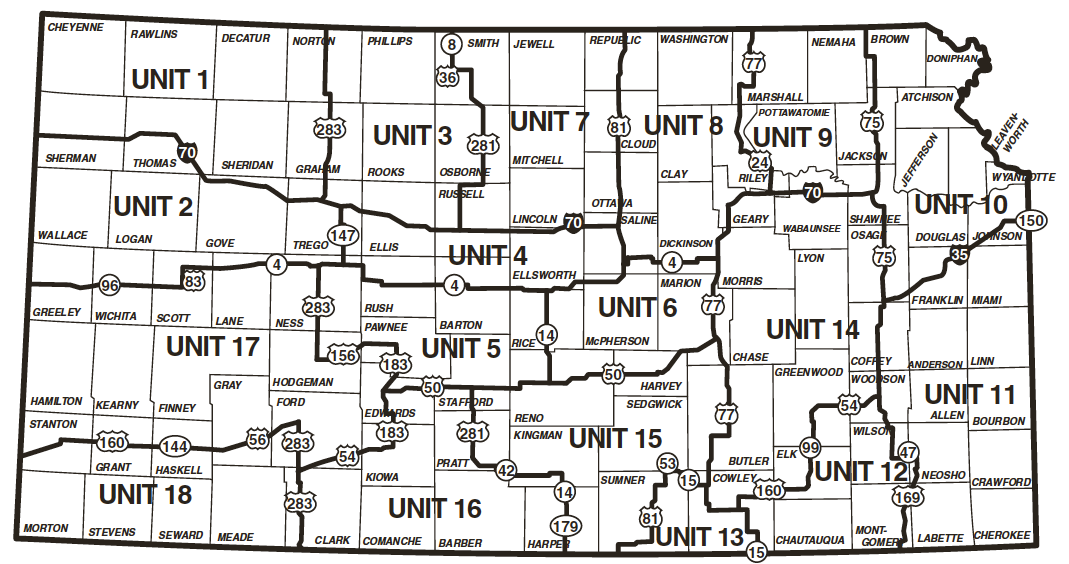
LEGAL DEFINITIONS
White-tailed Either-sex Deer: any buck, doe, or fawn white-tailed deer.Either-species/Either-sex Deer: any buck, doe, or fawn white-tailed or mule deer.Antlerless-Only White-tailed Deer: any white-tailed deer without a visible antler plainly protruding from the skull.Antlerless-only Deer: any white-tailed or mule deer without a visible antler plainly protruding from the skull.
EITHER-SPECIES/ EITHER-SEX ZONES (RESIDENT)
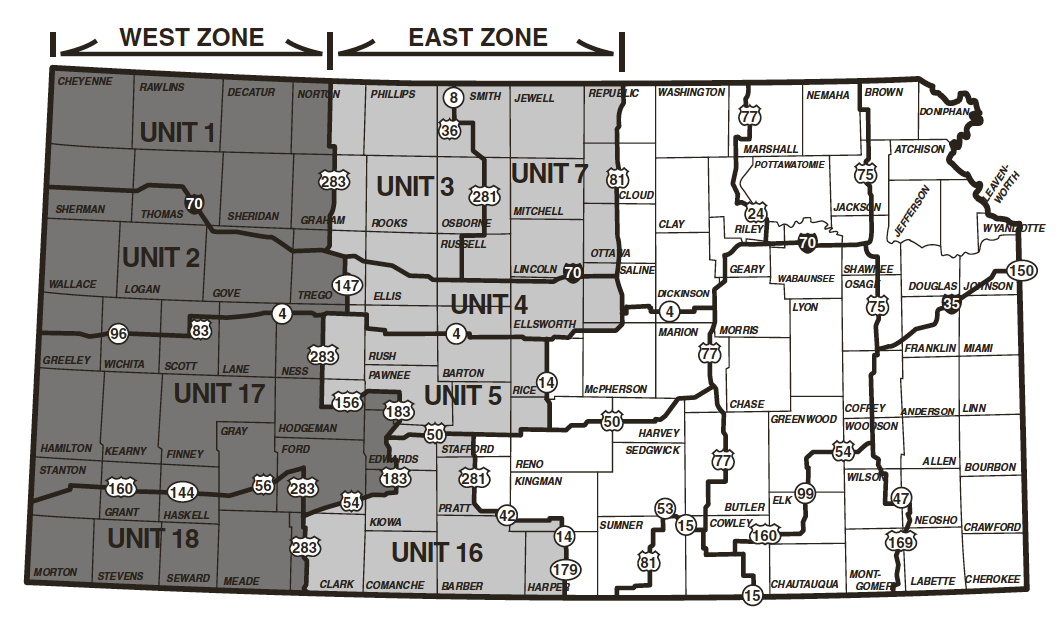
URBAN DEER MANAGEMENT UNITS 19 & 10A
Urban deer management units were created to focus greater deer harvest in the Kansas City-to-Topeka corridor. Unit 19 will host an extended archery season (Jan. 23-31, 2023).
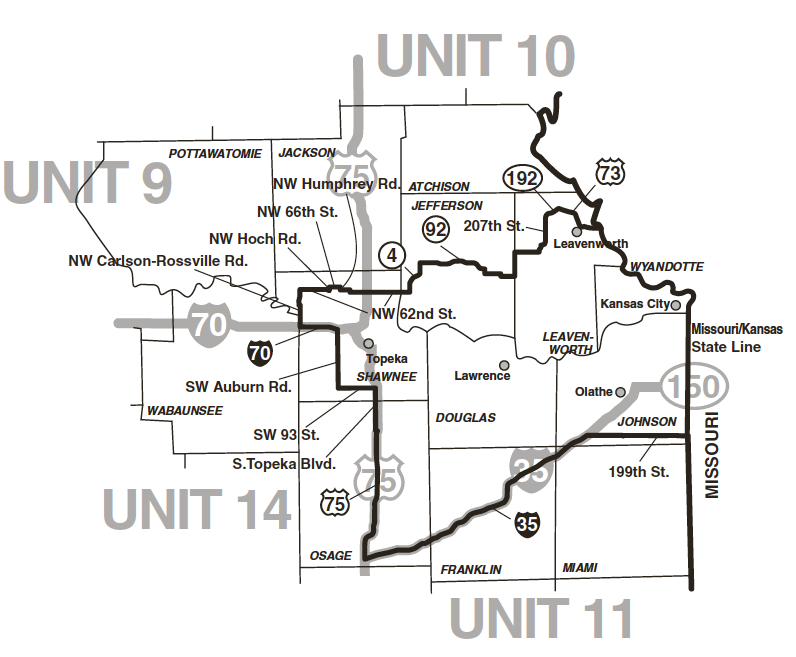
Unit 10A is Fort Leavenworth and is open to active and retired military staff only.
All properties owned or managed by KDWPT, except WIHA areas, are excluded from Unit 19. These properties are open only under their original unit. For example, Clinton Wildlife Area and Douglas State Fishing Lake are open only during Unit 10 seasons.
WHO MAY HUNT IN UNIT 19
- Unit 9, 10, 11, and 14 permit holders, with permit season and equipment restrictions.
- Archery permit holders during the regular archery season; the Extended Firearm Whitetail Antlerless-only season, Jan. 1-22, 2023; and the Extended Archery Whitetail Antlerless-only season, Jan. 23-31, 2023. Hunter orange is required of all deer hunters during any firearm sea-son. State-owned and state-managed lands, excluding WIHA, are not included in Unit 19.
- Holders of Hunt-Own-Land permits valid in Unit 19, during any season with legal equipment.
- Holders of Whitetail Antlerless-only permits, during any season with legal equipment.
- Holders of Any-season/Either-sex Whitetail permits, during any season with legal equipment.
WHITETAIL ANTLERLESS ONLY UNITS
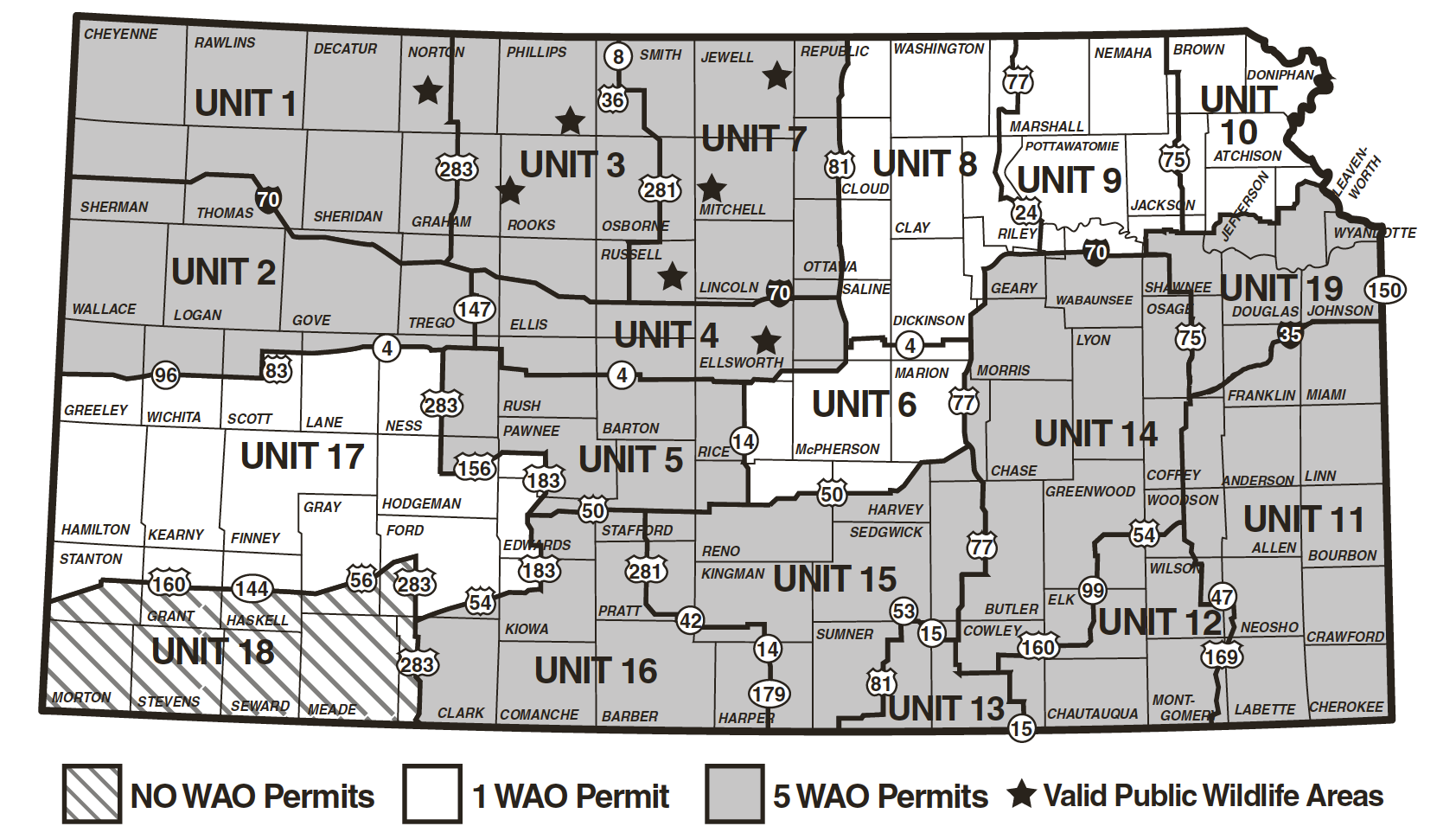
EXTENDED WHITETAIL ANTLERLESS ONLY (WAO) SEASONS
EXTENDED FIREARM WHITETAIL ANTLERLESS ONLY
Jan. 1-8, 2023 (DMU 6, 8, 9, 10, and 17)Jan. 1-15, 2023 (DMU 1, 2, 3, 4, 5, 7, 11, 14 and 16)Jan. 1-22, 2023 (DMU 10A, 12, 13, 15 and 19)
Any unfilled 2022 deer permit valid in units open may be used dur-ing the extended whitetail antlerless-only seasons. Resident Either-species/Either-sex permits valid for the East or West zones are valid for an antlerless white-tailed deer only in units listed on the permit.
Any legal equipment may be used to take a white-tailed deer without a visible antler plainly protruding from its skull during the extended season. A valid Kansas hunting license is required, unless exempt by Kansas law. Hunter orange clothing is required.
EXTENDED ARCHERY WHITETAIL ANTLERLESS ONLY
(DMU 10A and 19) (Jan. 23-31, 2023)
The following unfilled permits are valid during this season using archery equipment only for antlerless whitetails. Resident and nonresident Archery Either-species/Either-sex permit, nonresident Archery White-tailed Deer permit, resident Any-Season White-tailed Deer permit, Hunt-Own-Land Permit valid within units 19 and 10A, Special Hunt-Own-Land permit valid within units 19 and 10A, and Whitetail Antlerless Only Deer permit. A valid hunting license is required, unless exempt by Kansas law. Unit 10A is Ft. Leavenworth and is open only to active and retired military staff.
The first Whitetail Antlerless Only permit purchased is valid statewide except DMU 18, including all public lands and WIHA. Up to four additional Whitetail Antlerless Only permits may be purchased and are valid in the units shaded above on private land with permission, WIHA and the public wildlife areas designated with stars.
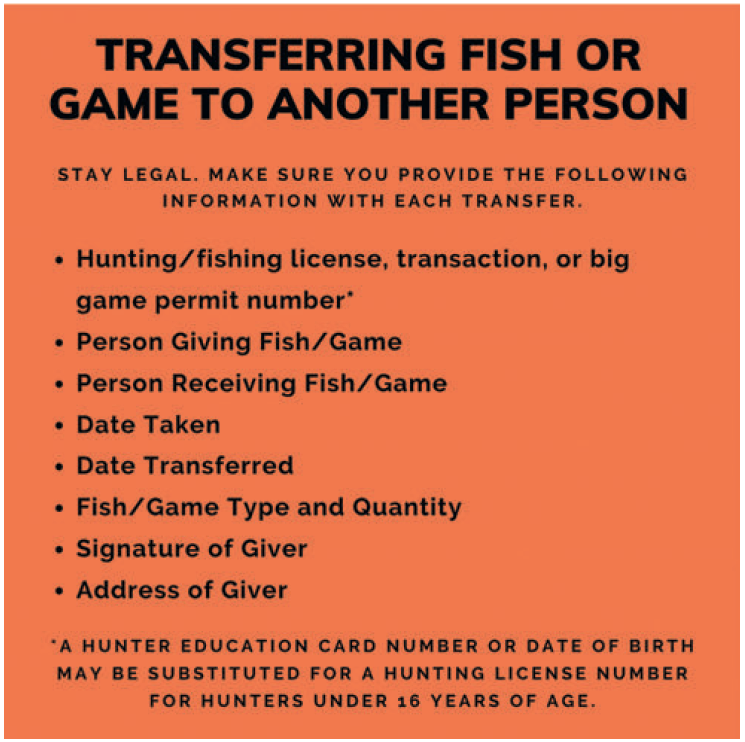
PERMIT DESCRIPTIONS (Hunting restricted to units listed on permits.)
RESIDENT ANY-SEASON WHITE-TAILED DEER
Bag limit: One (1) buck, doe, or fawn white-tailed deer Any-season White-tailed Deer permits are valid statewide in any season with equipment legal for that season. Available over the counter through Dec. 30 to residents and landowner/tenants only.
RESIDENT FIREARM EITHER-SPECIES/EITHER-SEX (application online only)
Bag limit: One (1) buck, doe, or fawn white-tailed or mule deer FFirearm Either-species/Either-sex Deer permits are valid either in the West Zone or in the East Zone (see map on Page 19) during the regular firearm season using any legal equipment. Available to resi-dents and landowner/tenants by draw only (deadline to apply is June 9, 2023).
RESIDENT MUZZLELOADER EITHER-SPECIES/EITHER-SEX
Bag limit: One (1) buck, doe, or fawn white-tailed or mule deer Muzzleloader Either-species/Either-sex Deer permits are valid either in the West Zone or in the East Zone during the muzzleloader-only and regular firearm seasons using muzzleloading or archery equipment. Available over the counter through Dec. 30 to residents and landowner/tenants only.
RESIDENT ARCHERY EITHER-SPECIES/EITHER-SEX
Bag limit: One (1) buck, doe, or fawn white-tailed or mule deer Resident Archery Either-species/Either-sex Deer permits are valid statewide with archery equipment during archery season. Available over the counter through Dec. 30 to residents and landowner/tenants only.
NONRESIDENT MUZZLELOADER WHITE-TAILED DEER COMBO (application online only)
Bag limit: One (1) buck, doe, or fawn white-tailed deer AND one (1) white-tailed antlerless deer
Nonresident Muzzleloader White-tailed Deer Combo permits are available only by draw (deadline to apply is April 28, 2023) and are valid in two adjacent units listed on permit during the muzzleloader-only and regular firearm seasons. Nonresidents receiving a Muzzleloader White-tailed Deer permit in Deer Management Unit 1, 2, 3, 4, 5, 7, 17 or 18 may also apply for one of a limited number of Mule Deer Stamps. If drawn, their permit becomes a Nonresident Muzzleloader Either-species/Either-sex permit with a bag limit of one (1) buck, doe, or fawn white-tailed or mule deer in two designated adja-cent units listed on permit. If the hunter selects an adjacent unit not list-ed above, the permit is valid for a white-tailed buck, doe, or fawn in that unit. The permit is still valid for either species in the original unit.
NONRESIDENT ARCHERY WHITE-TAILED DEER COMBO (application online only)
Bag limit: One (1) buck, doe, or fawn white-tailed deer AND one (1) white-tailed antlerless deer
Nonresident Archery White-tailed Deer permits are available only by draw (deadline to apply is April 28, 2023) and are valid in two adjacent Deer Management Units listed on permit and DMU 19 (during special seasons). Nonresidents who receive a Nonresident Archery White-tailed Deer permit in Deer Management Unit 1, 2, 3, 4, 5, 7, 17 or 18 may also apply for one of a limited number of Mule Deer Stamps. If drawn, their permit becomes a Nonresident Archery Either-species/Either-sex permit with a bag limit of one (1) buck, doe, or fawn white-tailed or mule deer in two designated adjacent units listed on per-mit. If the hunter draws the mule deer stamp in one of the units listed above but selects an adjacent unit not listed above, the permit is valid for a white-tailed buck, doe, or fawn in that unit. The permit is still valid for either species in the original unit.
NONRESIDENT FIREARM WHITE-TAILED DEER COMBO (application online only)
Bag limit: One (1) buck, doe, or fawn white-tailed deer AND one (1) white-tailed antlerless deer
Nonresident Firearm White-tailed Deer permits are available only by draw (deadline to apply is April 28, 2023) and are valid in unit selected and one adjacent unit listed on permit during the regular firearm season.
HUNT-OWN LAND
Bag limit: One (1) buck, doe, or fawn white-tailed or mule deer
Hunt-Own-Land permits are valid for any season with equipment legal for that season, and only on lands owned and operated for agri-cultural purposes. This permit is available to individuals who qualify as landowners, tenants, nonresident landowners or as family members living with a resident landowner or tenant. This permit is not transferable.
SPECIAL HUNT-OWN-LAND
Bag limit: One (1) buck, doe, or fawn white-tailed or mule deer
This permit may be issued to a resident landowner’s or tenant’s siblings and lineal ascendants or descendants, or their spouses, whether or not Kansas residents. (For example, a grandson or his wife, daughter or her husband, a parent, or a brother or his wife would be eligible for this permit. A landowner’s or tenant’s uncle, aunt, nephew, niece, or cousin are not eligible for this permit.) The permit is valid only on lands owned or operated by the landowner or tenant, and may be used in any season with equipment legal for that season. Permits are limited to one per 80 acres owned or operated. A nonresident hunting with this permit must have a nonresident hunting license.
WHITETAIL ANTLERLESS ONLY
Bag Limit: One (1) white-tailed deer without a visible antler protruding from skull
Hunter who possess a permit that allows the taking of an antlered deer may purchase as many as five (5) Antlerless White-tailed Deer permits. The first Whitetail Antlerless-only permit purchased is valid statewide except DMU 18, including all public lands and WIHA. Up to four additional such permits may be issued to the same individual and are valid only in units 1, 2, 3, 4, 5, 7, 10A, 11, 12, 13, 14, 15, 16 and 19 on private land with landowner permission, on Walk-In Hunting Areas, and on Glen Elder, Kanopolis, Lovewell, Norton, Webster and Wilson wildlife areas and Kirwin National Wildlife Refuge. All Whitetail Antlerless Only permits are valid during any season with equipment legal for that season.
YOUTH PERMITS (15 and younger)
Reduced price youth permits are valid for the seasons specified on the permit. In addition, they are valid during the September youth/disabled season. During the youth season, hunters 16 and younger may hunt under adult supervision. However, hunters who are 16 are not eligible for the youth-priced permits.
POST-HARVEST INSTRUCTIONS
At the time of purchase, hunters will have the option of paper carcass tags or e-tags.
Paper tags: Sign permit prior to hunting to validate it. After an animal is killed, the carcass tag must be signed, dated and attached to the animal in a visible manner before the carcass is moved from the harvest site.
Paper permits and tags purchased through the internet must be printed on a desktop printer at the time of purchase. To protect a non-waterproof paper tag, place it in a clear plastic bag and attach it to the leg of the animal with a zip-tie or other attachment.
The carcass tag must remain attached to the animal during transport and kept with the meat until it is consumed, given to another or otherwise disposed of.
Animals taken with antlerless-only permits must be transported with the head attached to the carcass. However, it is best not to transport carcasses from areas with known cases of chronic wasting disease (CWD) to prevent spreading the disease. An animal taken with an antlerless-only permit may be quartered as long as genitalia is left attached to one of the rear quarters, leaving the spinal column and head at the hunting site. Or an antlerless animal may be boned out at the kill site if it is registered electronically. The voluntary registration process allows hunters to send photos of the animal with the carcass tag attached to KDWPT before boning the meat. A confirmation number will be sent, which will allow transport of the meat. The carcass may be left at the hunting site. To learn more about electronic registration, visitksoutdoors.com/programs, then click “Electronic Deer Check-in.”
Mobile/E-tags: Hunters who choose e-tags will keep the big game permit and e-tag on their mobile device. To validate an e-tag when an animal is killed, open the “HuntFishKS” mobile app and record the date and time of kill and enter a photograph of the entire carcass with sufficient clarity to display the species and whether it is antlered or antlerless. Once the data and photo are submitted, a confirmation number will be displayed within the app must be kept on the mobile device during transport and retained by the hunter until the meat is consumed, given to another or otherwise disposed of. An e-tag confirmation number will work the same as electronic registration for a hunter wanting to bone out an animal taken with an antlerless-only permit and transport only meat.
Survey: Hunters may be requested to complete an online KANSAS DEER HUNTER HARVEST SURVEY at the end of the season. Information received helps biologists make decisions and manage a healthy herd. A random sample of hunters will be contacted after the season, making it important for hunters to update address information each year when they purchase a permit. Hunters surveyed will receive an email or a postcard with a weblink to direct them to a website with the online survey. Questions about this survey or assistance in completing it may be obtained at the KDWPT Research and Survey Office, (620) 342- 0658. State law (K.S.A. 32-937) requires that deer hunters receiving a harvest report card complete the survey.
TICK-BORNE DISEASES
Ticks can carry germs that cause serious and sometimes deadly diseases such as tularemia, ehrlichio-sis, anaplasmosis, Rocky Mountain spotted fever, and Lyme disease. Tick-borne diseases are transmitted to humans when an infected tick bites a human. In Kansas, approximately 300 people are diagnosed with tick-borne diseases every year.
Because ticks live in grassy, brushy, or wooded areas, and on animals, hunters are at an increased risk of contracting
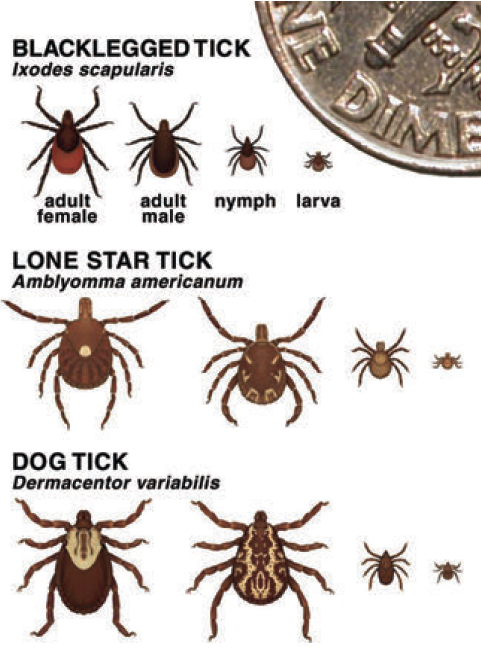
tick-borne diseases.
In Kansas, ticks most likely to cause disease in humans and animals are American dog ticks, Lone Star ticks, and Blacklegged ticks.
Common signs and symptoms following contact with an infected tick include fever, rash, or flu-like illness. Symptoms may not appear for seven to 21 days after a bite. Most tick-borne diseases can be effec-tively treated if recognized early, so hunters should notify their doctor of any recent tick bites or outdoor activities where exposure to ticks may have occurred.
Permetherin-treated clothing and gear is a deterrent to ticks, and remains effective through several washings; Permetherin should not be applied to skin. Insect repellents registered through the Environmental Protection Agency (EPA) containing DEET, picaridin, IR3535, oil of lemon eucalyptus (OLE), paramenthanediol (PMD), or 2-undecanone can effectively repel ticks, and may be applied to skin and clothing. Hunting dogs should also be treated with tick prevention products, as prescribed by a veterinarian.
Before going afield, hunters should tuck pants into socks and shirts into pants to prevent ticks from crawling inside clothing. It is wise to limit walking time on game trails, as ticks target these trails as a way to latch onto their wildlife hosts. Upon returning from the outdoors, hunters should immediately shower to remove any unattached ticks, then perform a body check. Ticks in larvae and nymph stages are harder to see than adult ticks, so thorough careful inspections are needed, especially in the armpits and waste line where belts restrict the upward movement of ticks. Dogs should also be inspected for ticks. Additionally, clothes that have been worn outside when ticks are active should be contained in an air-tight bag until washed, and shoes left outside, to help prevent ticks from entering a house. For a guide on how to perform a tick check, and how to remove ticks, visit https://www.cdc.gov/features/h….
IMPORTANT NOTE REGARDING TULAREMIA:
Most tick-borne diseases are spread through the bite of an infected tick. However, the bacteria that cause tularemia can also be spread through deer flies or contact with infected animals and their carcasses
Hunters should always wear gloves when handling sick or dead animals.
Hunting dogs can also contract tularemia if they’ve been in contact with infected game. If a hunting dog develops a fever, becomes depressed, or loses its appetite, consult a veterinarian immediately. Tularemia and other diseases have been passed from exposed dogs to humans because of dogs licking their owners’ faces.
CHRONIC WASTING DISEASE (CWD)
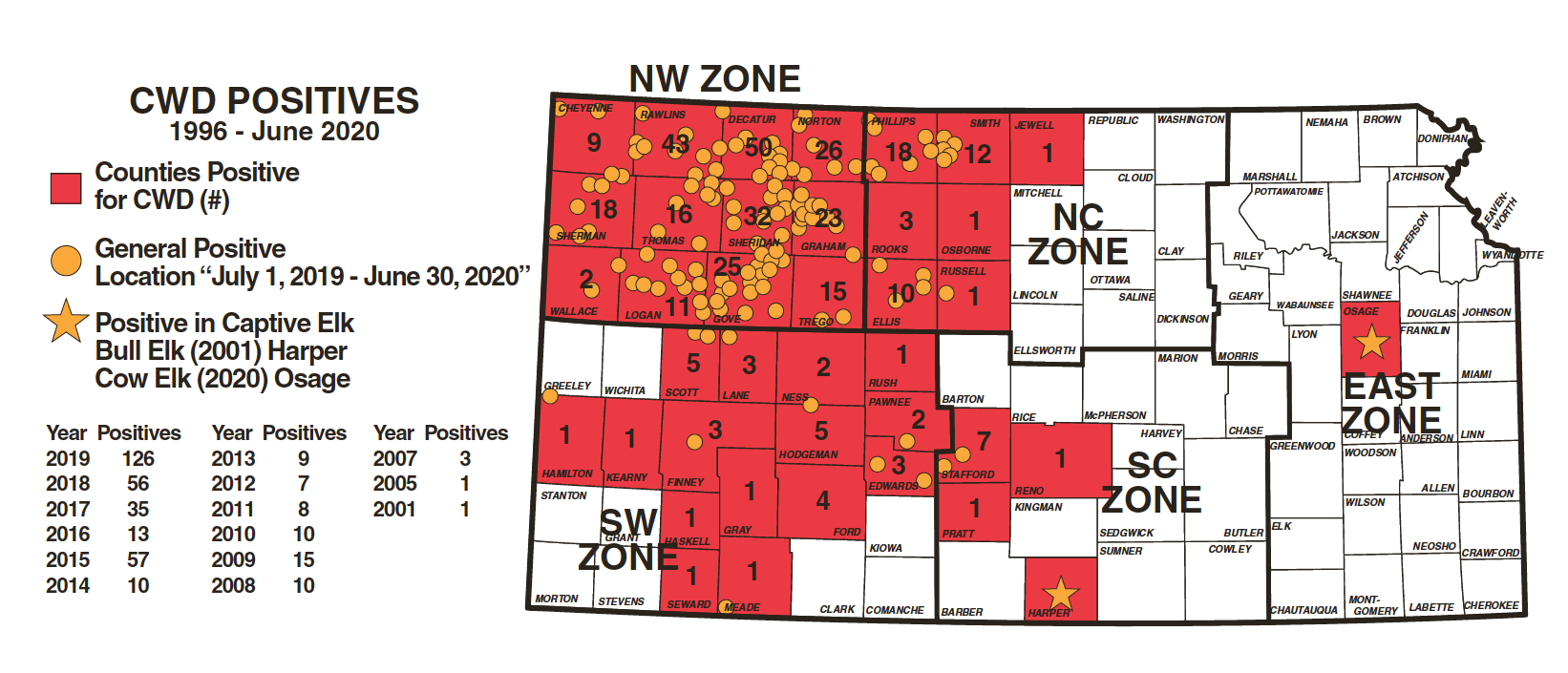
WHAT IS CWD?
Chronic Wasting Disease (CWD) is a contagious, neurological disease of deer, elk, moose and other cervids, caused by the deposition and clumping of abnormal proteins (prions) in the brain that kills neurons, resulting in cytoplasmic vacuolation and a characteristic sponge-like degeneration of the brains of infected animals. Outward symptoms of the disease include emaciation, abnormal behavior, excessive salivation and loss of bodily functions. Predators often see, kill, and eat these vulnerable, symptomatic animals long before they are seen by humans. Many times, CWD-positive deer are observed near outbuildings at farmsteads or near bodies of water. Symptoms don’t manifest until the last couple months before the cervid dies; therefore, most CWD-positive cervids are asymptomatic and look normal when they are harvested.
CWD belongs to a group of diseases known as transmissible spongiform encephalopathies (TSEs). Within this family of diseases, there are several other variants that affect domestic animals. Examples of TSEs include: scrapie, which has been identified in domestic sheep and goats for more than 200 years; bovine spongiform encephalopathy (BSE) in cattle (also known as “mad cow” disease); and transmissible mink encephalopathy (TME) in farmed mink.
A human form, Creutzfeldt-Jakob disease (CJD), occurs naturally and spontaneously in about one out of every one million people world-wide. Variant Creutzfeldt-Jakob disease (vCJD) has been associated with consumption of beef from the large-scale outbreak of BSE in cattle herds, starting in the 1980s, in Great Britain and over 220 people contracted vCJD. However, CWD has not been documented to have caused disease in humans to date, but due to the similarities of prions and certain lab experiments, hunters and those eating venison should take certain precautions to avoid exposure to abnormal prions to manage and lower exposure risk.
Impacts of CWD on population dynamics of deer and elk are presently unclear. Population impacts have been documented in mule deer, white-tailed deer and elk in restricted geographic areas, but it is uncertain whether CWD will impact herds on a larger geographic scale. Computer models suggest that CWD could substantially reduce infected cervid populations by lowering adult survival rates and destabilizing longterm population dynamics over the next several decades, resulting in fewer older animals (trophy animals) in the population.
The prion or infectious protein is very stable and resists environmental degradation and becomes more infective after it binds to clay par-ticles in the soil. Cervids are thought to become infected via animal-to-animal contact and indirectly via contaminated environment-to-animal transmission. Baiting, feeding, and artificially concentrating deer is not advised. Infected deer will excrete as many infectious prions throughout the course of its life (urine, feces, saliva, breath, etc.) as will be accumulated in the tissues of the animal at the time of its death.
IS THE MEAT SAFE TO EAT?
At this time, there is no evidence that CWD has been transmitted to humans. Despite our increasing understanding and knowledge of the
disease, there continues to be gaps in our complete understanding of the disease. Due to this uncertainty, its similarity with other known TSEs, and potentially longterm incubation time, hunters should not eat meat from animals known to be infected with CWD or exhibiting signs of any disease. Thoroughly cooking CWD-positive meat does not destroy prions. Prion destruction via heat starts at around 1,000 degrees F for an extended time. Hunters, especially in CWD areas, are advised to bone out their meat to avoid transporting prions to uninfected areas. Prions reside in carcasses, and an infected carcass has the potential to start a new focus of disease in a previously uninfected area. Electronic Deer Check-in is required to leave carcasses in the field that were taken with an antlerless permit. Deer taken with either-sex permits can be boned out in the field, leaving the carcass in the field, without using Electronic Deer Check-in. Each hunter must make the decision whether to consume wildlife or deer that test positive for CWD. KDWPT does not recommend eating wildlife that are sick or diseased. Here are bullet points from the Centers for Disease Control and Prevention regarding CWD precautions:
To minimize their risk of exposure to CWD, hunters should:
- Do not shoot, handle or eat meat from deer and elk that look sick or are acting strangely or are found dead.
- When field-dressing a deer: Wear latex or rubber gloves when dressing the animal or handling the meat. Minimize how much you handle the organs of the animal, particularly the brain or spinal cord tissues. Do not use household knives or other kitchen utensils for field dressing.
- Check state wildlife and public health guidance to see whether testing of animals is recommended or required. Recommendations vary by state, but information about testing is available from many state wildlife agencies.
- Consider having the deer or elk tested for CWD before you eat the meat.
- If you have your deer or elk commercially processed, consider asking that your animal be processed individually to avoid mixing meat from multiple animals.
- If your animal tests positive for CWD, do not eat meat from that animal.
DEER HARVESTED OUTSIDE THE SOUTHCENTRAL (SC) ZONE CAN BE TESTED FOR FREE THROUGH THE UNIVERSITY OF MISSOURI CWD STUDY.
CWD testing is not a food safety test. Testing is done to measure herd health, and all samples may not be tested if the target numbers of sam-ples have been obtained. Hunters will be notified by phone if their sample tests positive for CWD. It typically takes about 1-1.5 weeks to get a result once the sample arrives at KSVDL. Samples submitted through the University of Missouri are no cost to the hunter for testing but turnaround time for results is closer to 2-4 weeks. Keep in mind that when animals submit-ted to taxidermists may not immediately be sent out for testing but rather are sent to the lab in bulk a few times throughout the season.
Southcentral Zone samples will only be picked up from the sample collectors and delivered to KSVDL 2-3 times during the 2022-2023 deer seasons. If KDWP Southcentral Zone sample sizes are adequate, the Missouri CWD Study may start collecting and testing samples from the Southcentral Zone. Hunters have the option of freezing their venison until a result is obtained.(Freezing meat for 30 days is recommended before making jerky because this will help kill parasites present in the meat. Jerky is made at lower-than-normal cooking temperatures.) Hunters wanting a quicker result can submit samples privately by calling KSVDL Client Care at 785-532-5650. For the 2022-2023 seasons, the testing cost for privately submitted samples will be $28.. KSVDL provides test kits for $6.50, and shipping back to the lab is $7.50. If a deer head is submitted to KSVDL, there is a $16 fee for KSVDL to sample the head and a head dis-posal fee of $15.50.
2022-2023 SAMPLE COLLECTORS AVAILABLE TO ASSIST WITH SAMPLING DEER IN THE SOUTHCENTRAL “SC ZONE”:
Sample collector contact information will be posted at https://ksoutdoors.com/Hunting… in the coming months.
FREE CWD TESTING FOR DEER HARVESTED OUTSIDE OF THE SOUTHCENTRAL “SC ZONE”:
- Call or text 620-402-4195 or email [email protected] for more information.
- Hunters are invited to submit samples through participating KDWP offices, participating taxidermists/meat processors, or by submitting inde-pendently directly to the lab.
- Watch this video to learn how to sample a deer for CWD testing. https://www.youtube.com/watch?….
- Make sure to write down/remember the data card barcode number or the temporary Tyvek tag number of the sample when having your deer/elk sampled for CWD. The barcode number or Tyvek tag number are the numbers used when your result is posted on the website.
- Hunters will be notified by phone call if a deer they harvest tests positive.
- All CWD test results will be posted at ksoutdoors.com/Hunting/Big-Game-Information/Chronic-Wasting-Disease-CWD/2022-2023-CWD-Testing-Results.
NEW CHRONIC WASTING DISEASE RESEARCH PROJECT
KDWPT is requesting hunter assistance with a new three-year research project to better understand how different habitats affect the spread of Chronic Wasting Disease within your Kansas deer herd. Chronic Wasting Disease, if left unchecked, negatively affects deer populations by changing age structure and decreasing resilience, which can result in a deer herd that cannot maintain or grow in population size and has fewer mature individuals.
How can hunters help? Six different deer management units (DMUs) will be sampled each year of the project. Hunters who harvest a deer within one of the DMUs being sampled can submit a Chronic Wasting Disease sample to KDWPT for testing. Samples need to be accompanied by sex, age, and location information. To evaluate how habitat affects CWD in the deer herd, location information must allow for the identification of the section where the deer was harvested, such as GPS coordinates or section-township-range number. If you would like to know if your deer tests positive for CWD, include your name and phone number or KDWPT number. Testing of samples submitted for the research project will be completed at no cost to the hunter. Hunters harvesting multiple deer may submit multiple samples. Note: After caping is completed, samples can be collected from a deer that will be taxidermy mounted without affecting the mount; check with your taxidermist for specifics.
A map to assist you with section-township-range location information and a video showing how to collect the lymph node tissue sample for chronic wasting disease testing can be found at: ksoutdoors.com/Hunting/Big-Game-Information/Chronic-Wasting-Disease.
The map is also available in the ArcGIS Explorer App, simply search for “Kansas CWD Sampling Map” in the app. For more information about this research project, visit ksoutdoors.com/cwd.
In partnership with:









